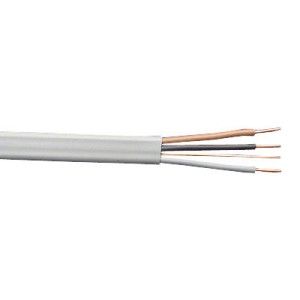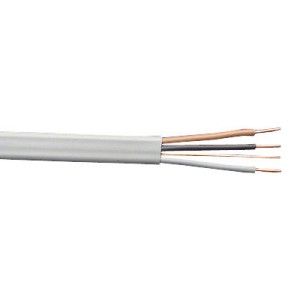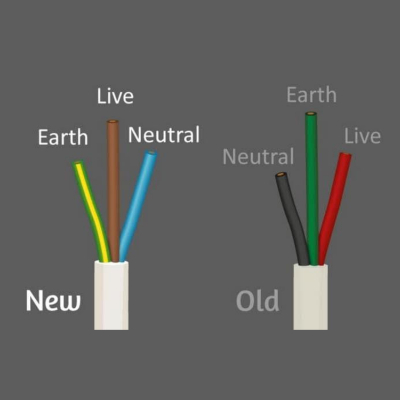3 Core and Earth
6243Y 3 Core and Earth Cables on 100 metre coils. This type of cable is BASEC, and British standards approved. The 3 Core and Earth range are perfect for domestic installation projects.
What is Three Core and Earth Cable used for?
Three Core and Earth Cables are mainly used for two-way lighting installations and in other situations that require a permanent and switched live along with a neutral, such as central heating, some types of lighting and extractor fans. The three core and earth cable are colour coded and has 3 sheathed conductors brown, black, grey and 1 bare earth conductor.
Please browse our Three Core and Earth Cables online and order today for next-day delivery.
3 core and earth cables are used to connect electrical devices, equipment, and devices to mains power. All kinds of applications have to be considered within any electrical project, and according to the specifications, the 3 core cable size to use and how the circuit is designed all impact the result.
It is also a fact that high-voltage applications often require high-ware cabling like steel armoured (SWA) cabling systems. Being familiar with the 3 core and earth cable that is armoured, and what each colour conductor is used for therefore becomes essential.
Uses of 3 Core & Earth Cable
A 3 core and earth cable are most commonly used in applications such as 2-way lighting for residential use, wiring to central heating systems, and other devices. Whether the 3 core and earth cable required will have a neutral or live application all depends on how the electrician in charge decides to design the circuit for the application.
In most cases, 3 core cables tend to be an electrical wire that has three separate copper conductors, each within its protective jacket, sheathed in an external jack or protective sheathe. The case with a 3 core and earth cable is different because there is a fourth conductor inserted during the manufacturing process.
The conductors in a 3 core and earth cable are neutral, earth, and live wires. For clarity, please note that wiring colors differ from three phase wiring and three phase wiring colors. If you're handling wiring yourself, it's vital to be able to identify new wiring colors of each conductor wire in 3 core and earth cable. Here is a quick guide on UK electrical wiring colours. Let's discuss 3 Core and Earth and general electrical wire colours, old and new.
What color is live wire?
Old wire colour codes have undergone many updates in the UK so the UK electrical wire colors code is different from what it used to be. Knowing how to identify a live wire is of great importance since it is the most dangerous of the conductors. So, what color is the live wire? Is brown the live wire? Yes, nowadays, a live wire is brown in color. Previously, live cable color used to be red in color. If your live wiring is red in color, we highly recommend you have it replaced. If you're wondering "what colour is live in a plug?" the answer is still brown. UK plug wire colours are the same as any other wiring colours. This also applies to lighting wire colours and mains wire colours.
What color is neutral wire?
Neutral wiring moves electricity away from appliances to prevent electrical overloads. So, what colour is a neutral wire? Is black live or neutral? A neutral wire nowadays is typically blue in color and is found at the end of an electrical circuit. It is important to note that these are specifically UK electrical wire colours. Old wire colours dictated that neutral wiring be black in colour, but that has been updated since 2006.
UK electric wire colours and plug wire colours are consistent across the country but also exclusive. If your wiring is from a different country and you are handling it yourself, you must read up on the wire color codes before installing it. If your electrical setup has old electrical wiring colours, it is recommended that you have them replaced and updated.
What color is earth wire?
A commonly asked question is "what does an earth wire do?" or "how does an earth wire work?". So, what is the purpose of the earth wire? The earthing wire functions to lend a path of electrical current into the ground. This acts as a protective measure in case of a wire malfunction. If a live current is passing through the wiring and you come in contact with it, an earthing cable protects you by preemptively directing the current into the ground.
Earth wires are yellow/green in colour as per wire colour code UK.
To sum up UK cable colours:
- What color wiring is live? Brown
- What color wiring is neutral? Blue
- What color wiring is earth? Yellow/Green
Why does a plug need a live and neutral wire?
A plug has both nuetral and live wiring as they both serve important functions. The live wiring carries the alternating potential difference from the electrical supply. The nuetral wiring, on the other hand, completes the circuit. Plugs typically have earth wires as well to ground the circuit and make it safe.
Why Replace Old Wiring to New Wiring?
Old electrical wiring poses many dangers to your space. So, a good way to identify when your wiring was last updated is by its live, earth, and neutral colors. Old wire colours are; black (neutral) and red (live). Earth wires tended to be yellow/green or bare.
To sum up old UK wire colours;
- Black (Neutral)
- Live (Red)
- Earth (Yellow/Green/Bare)
Now that we've covered UK house old wiring colours, let's talk about armoured 3 Core and Earth cables.
What is an Armoured 3 Core & Earth cable used for?
An armoured 3 core & earth cable is also known as the 3 core steel wire armoured (SWA) cable. In electrical circuits, this type of 3 core and earth cable also has additional words under their specifications that relate to the British Standards of cable manufacture and testing. Armoured cable earthing requirements are rigorously updated and need to be consistent everywhere in the UK.
The armoured 3 core and earth cable is known to be a power and auxiliary controlling cable which is used to transport mains power to residential or commercial installations. They are classified as hard-wearing cables and are typically used in applications where the risk of damage to the cable is high, or if there is a danger of UV exposure.
When it comes to the SWA 3 core and earth cable, they are particularly suited for external electrical applications because of their durability and strength. SWA 3 core and earth cables have an added layer of external casing made up of wire meshing to give it an extra layer of protection. This keeps the inner core of the 3 core and earth cable safe.
An SWA 3 core and earth cable are commonly used to transmit power underground – it is transmitted from a power generation source to a residence or commercial location. 3 core and earth cables and other cables such as the 4mm armoured cable are also used with a catenary wire in overhead power delivery applications.
More 3 Core and Earth Cable Uses
As every 3 core and earth cable includes three conductors as part of the manufacturing process, each type of cable has different uses. A 3 core and earth cable is usually used for Appliance Class I connectivity.
This is because there is a specific requirement for such appliances to provide connectivity to earth. If a 2 core cable is used instead of a 3 core and earth cable for these applications, this may compromise the installation as a whole. In addition, un-earthed cables can easily expose users to dangerous electrical shocks.
Electricians may use other cable versions such as the 2 core cable if no earthing is required, such as for electrical projects that involve Appliance Class II components. This is because Class II appliances do not require connectivity to earthing.
If there is a great risk of electrocution, it is among those applications where the use of a 3 core and earth cable is specifically advised for. Electrocution can happen if the live wire touches the body of equipment or appliance.
In cases where the body of the appliance is made of non-conductive materials such as rubber, plastic, glass, or ceramic, then using a 3 core and earth cable is not necessary.
However, it is important to note that it may be safer to choose outdoor 3 core and earth cable as opposed to 2 core wire ones that have a conductive exterior made of metal, steel, iron, or copper. For applications such as bulb holders and lamp posts, 3 core cables should be used but for non-conductive applications, 2 core cables are acceptable.
At Meteor, you can find 3 core and earth cable options the PVC 1.0mm 3 Core & Earth Cable and the PVC 1.5mm 3 Core & Earth Cable.
What are the 3 Core and Earth Cable Colours?
There are specific colour requirements for both 2 and 3 core and earth cable types. Up until March 2004 when the British Standard BS 7671 made some changes, the 3 core and earth cable colouring standard was blue, yellow, and red. However, now the live wire is brown, the neutral blue, and the earth is a mix of yellow and green.
The main reason for the colour change was to synchronise cable colours with the rest of the European Union countries. Since the unified colour code has taken effect, if an application needs the use of a product such as the 3 core and earth cable, it will only be available in the new colouring code.
What is the difference between the 2 core and 3 core and earth cable?
The main difference between the two is that the 2 core cable does not include an earthing wire and can be used with any electrical appliance that does not have an outer surface made up of a non-conductive material.
In comparison, a 3 core cable can be used for such fittings but must be used with light, lamp, bulb holders, or fittings with a conductive or metal exterior surface to make sure there is no risk of electrocution or other serious injuries.
It is advisable to get any fitting or installation by a qualified professional electrician. Contact the expert customer services at Meteor for more information.
FAQ's
- What is 3 Core and Earth Cable?
- Where can 3 Core and Earth Cable be used?
- What are the 3 core and earth wiring colours?
- What colour is neutral in 3 Core and Earth cables?
- What is the difference between 3 core and 4 core?



